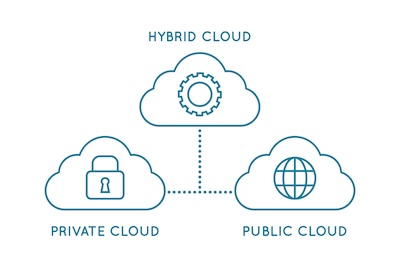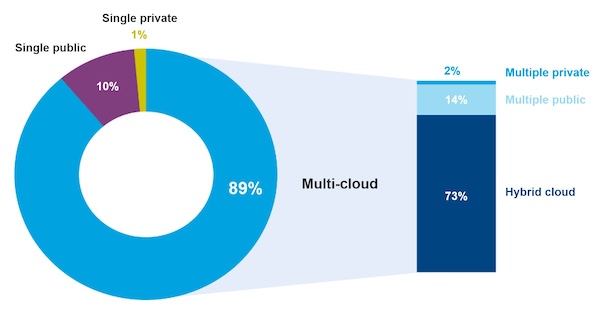Hybrid cloud adoption is on the rise as organizations recognize the need for a more flexible, scalable, and secure approach to managing their IT infrastructure.
Alongside the hybrid cloud, edge computing and wireless technology are also transforming how businesses operate, offering unprecedented possibilities for connectivity and data processing.
Understanding Hybrid Cloud
Hybrid cloud combines both public and private clouds, allowing organizations to leverage the benefits of both. Businesses can run some services or store data on their own servers and utilize the resources of the public cloud.
Public cloud services, such as those offered by Microsoft, Google, and Amazon, provide convenient on-demand, highly scalable, network access to a shared pool of configurable computing resources on a pay-as-you-go basis.
Private clouds are owned and managed by a single business, typically hosted in a traditional on-premise data center or by co-location providers, with only the organization having access to their data.
Currently, 73% of enterprise businesses are shifting toward the hybrid cloud model. This trend is expected to grow rapidly and become the new normal very soon.
There are challenges and benefits of using public and private clouds for different applications. For example, public clouds reducing latency and improving performance for real-time or high traffic mobile applications. While private clouds offer higher security and control.

What’s Driving the Move to Hybrid Cloud Architectures?
Cost: While using the public cloud can save money since businesses don't have to purchase servers and infrastructure, many businesses that moved to the public cloud discovered substantial costs for the service. There’s also the risk of hidden fees or price increases once user data is stored. By using a hybrid model, businesses can lower costs by only paying for the public cloud resources they need.
Stability and Security: Concerns about the stability and longevity of cloud providers, as well as their transparency about breaches and security practices, are also significant factors. With hybrid cloud, sensitive data can be stored in private clouds to ensure higher security and compliance with regulations, while less sensitive operations can be run on public clouds.
Flexibility: Hybrid cloud architectures also allow businesses to scale up during peak times and scale down during off-peak times, optimizing resource use and costs.
Customization: Organizations can tailor their cloud solutions to meet specific workloads, using the public cloud for scalable, on-demand resources and the private cloud for more secure, mission-critical operations.
The Importance of Low Latency and Edge Computing
Edge computing is becoming a key component of hybrid architecture, extending hybrid cloud functionality closer to the user. This trend is continuing to grow – spending on enterprise edge infrastructure is outpacing traditional network equipment and overall IT expenditures, reflecting this shift.
Recent events have necessitated the decentralization of processing loads, requiring connectivity and data access in various settings. This shift involves making decisions about whether data should be sent back to the public cloud, the private cloud, or what should be processed locally.
The concept of "edge" has expanded significantly; it can vary in size and location—from parking lots to homes, baseball stadiums, or even different countries. It can be in a traditional rack in a hospital telecom room, a standalone enclosure in a retail space, or an outdoor enclosure on a college campus.
Factors influencing the shift to the edge include:
Artificial Intelligence: AI requires massive data volumes, computing power, advanced security, and rapid scalability. With a hybrid cloud model, businesses can maintain greater control over their critical data and AI models by keeping them on private clouds, while still leveraging the computational power for processing less-sensitive information in public clouds.
Video Streaming: The constantly changing demands on video streaming platforms, like those for live sports events, often creates temporary demand spikes. Hybrid cloud architectures allow providers to seamlessly scale their content delivery resources to match these fluctuations, ensuring high-quality video streaming.
Advances in Wireless technology: Wireless technology like Wi-Fi, DAS and cellular, play a key role in facilitating seamless connectivity for a multitude of devices, supporting real-time applications and data-driven decision-making. As these technologies improve, they expand the use cases and increase the demand for low-latency communication, supporting real-time applications like autonomous vehicles, industrial automation, and smart cities.
The Rise of the Industrial Telecom Room
With the increasing need to store and process data in new, challenging, and outdoor edge compute environments, the rise of the “industrial” telecom room is becoming a critical aspect of modern network infrastructure.
As we deploy more wireless technologies, including more Wi-Fi access points (APs), distributed antenna systems (DAS), and sensors to ensure connectivity, these devices also need proper support and protection to function effectively in diverse environments.
IT Infrastructure to Support Hybrid Cloud:
For On-Premise or Edge Data Centers:
Moving compute resources to a private cloud requires infrastructure capable of handling demanding cloud applications uses significant computing power, leading to much higher rack densities and heat generation.
Expanding Beyond the Traditional Telecom Room to the Edge:
As the number of devices increases everywhere, there's an essential need to deploy more telecom rooms beyond traditional indoor, air-conditioned settings to outdoor and remote locations where traditional facilities cannot reach.
- Protection: Use NEMA 4, 4X, and 12 enclosures to protect equipment from the indoor and outdoor elements.
- Thermal Management: To maintain optimal operating temperatures.
- Remote Management: Use of intelligent PDUs for remote management and troubleshooting capabilities for sites that are difficult to access.
- Security and Access Control: Protecting equipment from human interference
- Aesthetic Considerations: As more of these devices are installed in our surroundings, it's important that installations blend into their environment, which also improves security.
Infrastructure for Deploying Wireless Access Points:
As more access points provide connectivity at the edge, the installation and maintenance of these points are more complex than simply clipping them into place. Proper installation and protection are crucial.
- NEMA Wireless Enclosures: Protect from dust and moisture in various environments, such as cafeterias and lavatories.
- Proper Mounting: Ensure optimal coverage in a large variety of challenging environments.
- Built-in Cabling Support: Many experts recommend that four Category 6A cables or fiber optic cabling should be deployed to each AP to future-proof the network. Use enclosures with built-in support for cable management for reliability.
- Security: Protect wireless equipment from tampering and interference.
- Aesthetic Considerations: Ensure installations blend in with their surroundings to enhance security and reduce visual clutter in public spaces.
Looking for wireless enclosures that can handle tough environments? Oberon™ has you covered. Check out their solutions here: Oberon Solutions Guide.
The Exciting Future of Enterprise Networks
The future of enterprise networks is exciting, with advancements in hybrid cloud, edge computing, and wireless technology. These innovations bring both potential benefits and challenges, requiring organizations to adapt and embrace these transformations.
To learn more, check out our free on-demand webinar, "Transforming Enterprise Networks: The Impact of Hybrid Cloud, Edge, and Wireless Advances." Tom Cabral, Field Application Engineer at CPI, explores practical strategies to ensure robust and secure enterprise networks that can adapt to the demands of the future.
Watch the Webinar.